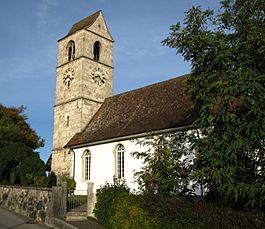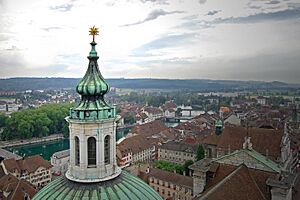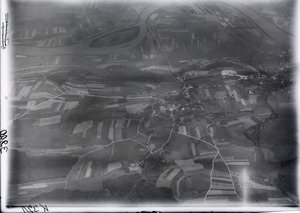Lüsslingen facts for kids
Quick facts for kids
Lüsslingen
|
||
|---|---|---|

Lüsslingen village church
|
||
|
||
| Country | Switzerland | |
| Canton | Solothurn | |
| District | Bucheggberg | |
| Area | ||
| • Total | 3.19 km2 (1.23 sq mi) | |
| Elevation | 439 m (1,440 ft) | |
| Population
(December 2020)
|
||
| • Total | 522 | |
| • Density | 163.6/km2 (423.8/sq mi) | |
| Postal code |
4574
|
|
| Surrounded by | Bellach, Biberist, Lohn-Ammannsegg, Lüterkofen-Ichertswil, Nennigkofen, Selzach | |
Lüsslingen was once a small town, or municipality, in Switzerland. It was located in the canton of Solothurn, in a region called Bucheggberg. On January 1, 2013, Lüsslingen joined with another town, Nennigkofen, to create a new, larger municipality called Lüsslingen-Nennigkofen.
Contents
A Look at Lüsslingen's Past
Lüsslingen is quite old! The first time anyone wrote about it was in the year 1251. Back then, it was known as in Luslingen.
Exploring Lüsslingen's Geography
Lüsslingen covered an area of about 3.19 square kilometers (which is about 1.23 square miles). A big part of this land, over half, was used for farming. About a quarter of the area was covered by forests.
Some of the land was used for buildings and roads. A small part was rivers or lakes. Lüsslingen is located on the northern side of the Bucheggberg mountain. It was the closest town in its district to the city of Solothurn.
What is Lüsslingen's Coat of Arms?
A coat of arms is like a special symbol or logo for a town or family. Lüsslingen's coat of arms shows a green linden tree growing from a green base, all on a silver background.
Who Lives in Lüsslingen?
In 2011, Lüsslingen had a population of 514 people. Many people living there were Swiss citizens. Some people were from other countries. Over the years, the number of people living in Lüsslingen has changed.
Languages Spoken in Lüsslingen
Most people in Lüsslingen speak German. This is the main language in many parts of Switzerland. Some other languages spoken there include Albanian and Arabic.
Age Groups in Lüsslingen
In 2000, about 5.6% of the people in Lüsslingen were young children (0-6 years old). Teenagers (7-19 years old) made up about 16.4% of the population. Most adults were between 25 and 44 years old. There were also many older adults and seniors living in the town.
The chart below shows how the population of Lüsslingen has changed over many years:

How People Make a Living in Lüsslingen
In 2010, the unemployment rate in Lüsslingen was 5.1%. This means that about 5 out of every 100 people who wanted to work did not have a job.
Jobs in Different Sectors
People in Lüsslingen worked in different types of jobs:
- Primary sector: These jobs involve getting raw materials, like farming. In 2008, about 21 people worked in this area, mostly in agriculture.
- Secondary sector: These jobs involve making things, like in factories or construction. About 209 people worked in this sector, mostly in manufacturing.
- Tertiary sector: These jobs provide services, like shops, restaurants, or schools. About 40 people worked in this sector.
Many people who lived in Lüsslingen also worked in other towns. Also, many people from other towns came to Lüsslingen for work. Most people used a private car to get to work.
Religion in Lüsslingen
In 2000, most people in Lüsslingen belonged to the Swiss Reformed Church. A smaller number were Roman Catholic. Some people belonged to other Christian churches or were Islamic. About 11% of the population did not belong to any church.
Learning and Education
Many adults in Lüsslingen have completed high school. Some have also gone on to get higher education from a university or a special college called a Fachhochschule.
In 2000, some students from Lüsslingen went to schools in other towns. Also, some students from other towns came to study in Lüsslingen.
See also
 In Spanish: Lüsslingen para niños
In Spanish: Lüsslingen para niños






